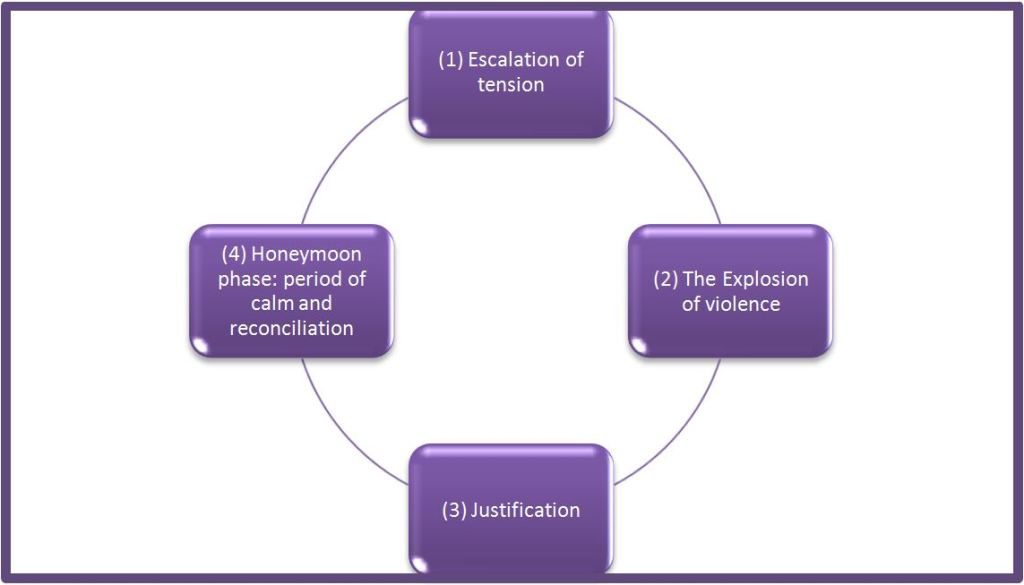
Domestic violence can happen to anyone of any race, age, sexual orientation, religion or gender.
It can happen to couples who are married, living together or who are dating. Domestic violence affects people of all socioeconomic backgrounds and education levels.
Abuse is a repetitive pattern of behaviors to maintain power and control over an intimate partner. These are behaviors that physically harm, arouse fear, prevent a partner from doing what they wish or force them to behave in ways they do not want.
Abuse includes the use of physical and sexual violence, threats and intimidation, emotional abuse and economic deprivation.
Many of these different forms of abuse can be going on at any one time.
The Power & Control Wheel that was developed by Domestic Abuse Program in Duluth, Minneapolisdescribes most accurately what occurs in an abusive relationship.
Think of the wheel as a diagram of the tactics your abusive partner uses to keep you in the relationship.
While the inside of the wheel is comprised of subtle, continual behaviors, the outer ring represents physical, visible violence. These are the abusive acts that are more overt and forceful, and often the intense acts that reinforce the regular use of other subtler methods of abuse.

The above text is taken from the website http://www.thehotline.org/help/
@Copyright – The National Domestic Violence Hotline
Psychological Violence
Verbal: swearing, insults, threats, name-calling, put-downs
Social: Aims at the isolation of the victim. The perpetrator forbids the victim to have any contact with relatives, friends, neighbours or even to work.
Economic: Full economic dependence of the victim from the abuser.
(Rejection, insecurity, lack of respect, Απόρριψη, ανασφάλεια, έλλειψη αλληλοσεβασμού, debasement, neglect, terror, shouting.)
Physical Violence
It refers to the violent behavior among family members that results in the violation of the person”s physical integrity that may range from minor to major injuries, or even result in the death of the victim (bruises, blows, scratches, burns, shaking, pinches, slaps …).
Sexual Violence
Forcing the victim to sexual acts with the use of violence, without the conscious consent of the victim (Intercourse, incest, unwanted touch, exposure to pornography, genital exposure).
Neglect
Neglect mainly concerns children, the elderly or other persons who are unable for various reasons to take care of themselves, for example, people with chronic serious health problems, disabilities etc.
The term “neglect” describes the phenomenon whereby one or more adults who are responsible for a person”s care, let the person undergo physical injuries or deprivation to such an extent that may lead to serious physical, mental, or emotional or social disorders or even death.
It is noted that people with caring relationship can except the parents, be other relatives as well as the institutions staff, teachers, child careers and others.
Child Witness Syndrome
When the child is exposed for a long time in various forms of domestic violence as a witness, without the child being physically abused. Violence between spouses is the most characteristic form, while other forms are abuse- physical and / or sexual -other brother in the family or violence against the grandfather or grandmother. Verbal violence (insults, threats) is one of the most characteristic forms of the syndrome of this syndrome.
Abuse is just a momentary loss of control.
Violence is not just a momentary loss of control but a pattern of behavior.
Abused people can leave their home whenever they want.
There are many reasons why it is very difficult for a person who is being abused to leave her/his house.
Abused people are masochists.
No one likes being abused.
Drinking alcohol leads to violent behavior.
Drinking alcohol is not the reason but an excuse.
The perpetrator will change if the victim becomes more docile and tries not to annoy him.
The perpetrator will always find reasons to exercise abuse.
Abuse does not cause injury.
Violence escalates and can reach up to the murder.
Children need their parents even if they are violent.
Children raised in a violent environment grow with developmental and psychological problems.
The phenomenon of violence occurs more frequently and more intensely to those in the lower class.
Violence exists in all socioeconomic strata.
People who are abused are not educated.
Abuse happens regardless of the person’s educational background.
People who are abused it is because they deserve it.
This is a myth used by the people who are abusive in an effort to prove that what they did is right.

Tension Building
During the tension building the perpetrator may swear and insult the victim in an effort to make the victim react. If the victim react, the perpetrator finds occasion to exert violence. Many times the victim fears the reaction of the perpetrator and thus behaves as if she is at fault. Eventually, the perpetrator will always find an excuse to exercise violence to the victim.
Violent Incident
During this phase the perpetrator is usually out of control. Many times the victim is seriously injured. Sometimes the victim remains passive in an effort to protect herself. Sometimes the victim simply defends herself. In some cases, the victim can hit the abuser, or run off and seek help.
Making-Up
After the abuse the victim is very vulnerable. The perpetrator attempts to justify his violent behavior, showering the victim with love and apologies. The abuser promises that he will not do it again.
During the Reconciliation phase, a very strong emotional bond between the victim and the perpetrator is created, which isolates both from reality.
But..
With time, the length of the three phases changes. The Tension Building phase lasts less and less, the Violent Incidence phase becomes more frequent and intense and the Making-up phase shrinks and becomes more intense. Violence weakens the victim and changes her character and personality.
Why does the victim stay?
There are many reasons why she does not leave, even if she feels that she is in danger:
- She does not perceive herself as a victim.
- She does not know her rights.
- She is afraid that he will take revenge against her or at the expense of the children.
- Religious and social beliefs.
- She does not work, and she cannot look for job easily since the perpetrator forbids it
or he forbids her from having contact even with her family.
- Economic Dependence.
- She is afraid that she will not find support from family and friends.
- She is afraid to report the abuse because she is afraid of the consequences that may result regarding her partner”s employment status.
- Fear / Threats
- Thinks of the children and that the family will be ”dissolved”.
- She feels hopeless.
- Believes she is weak.
- Low self-esteem.
- Fear of change.
- Despair.
- Blames herself.
Repeated abuse and stress from living in an abusive relationship often leads to chronic health problems.
People who are abused have 50% to 70% more possibility to develop the following health problems:
Long-term effects of domestic violence:
- Stress/ anxiety
- Chronic depression
- Chronic pain (psychogenic or pain from a blow that has no marks)
- Death
- Dehydration
- Alcohol or/ and drug abuse
- Eating disorders
- Excessive emotional reactions / expressions to various stimuli
- Emotional paralysis
- Post- traumatic stress disorder


 Ελληνικα
Ελληνικα





